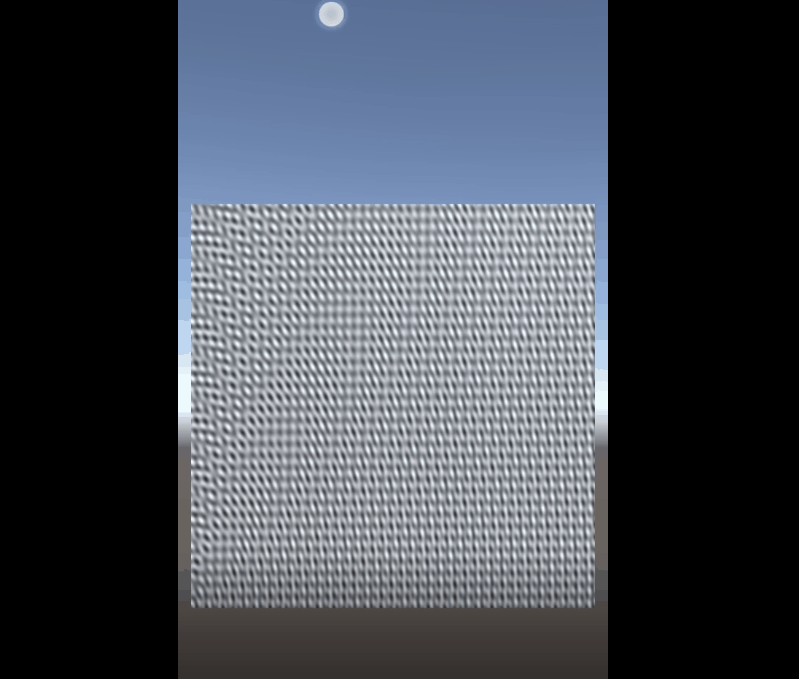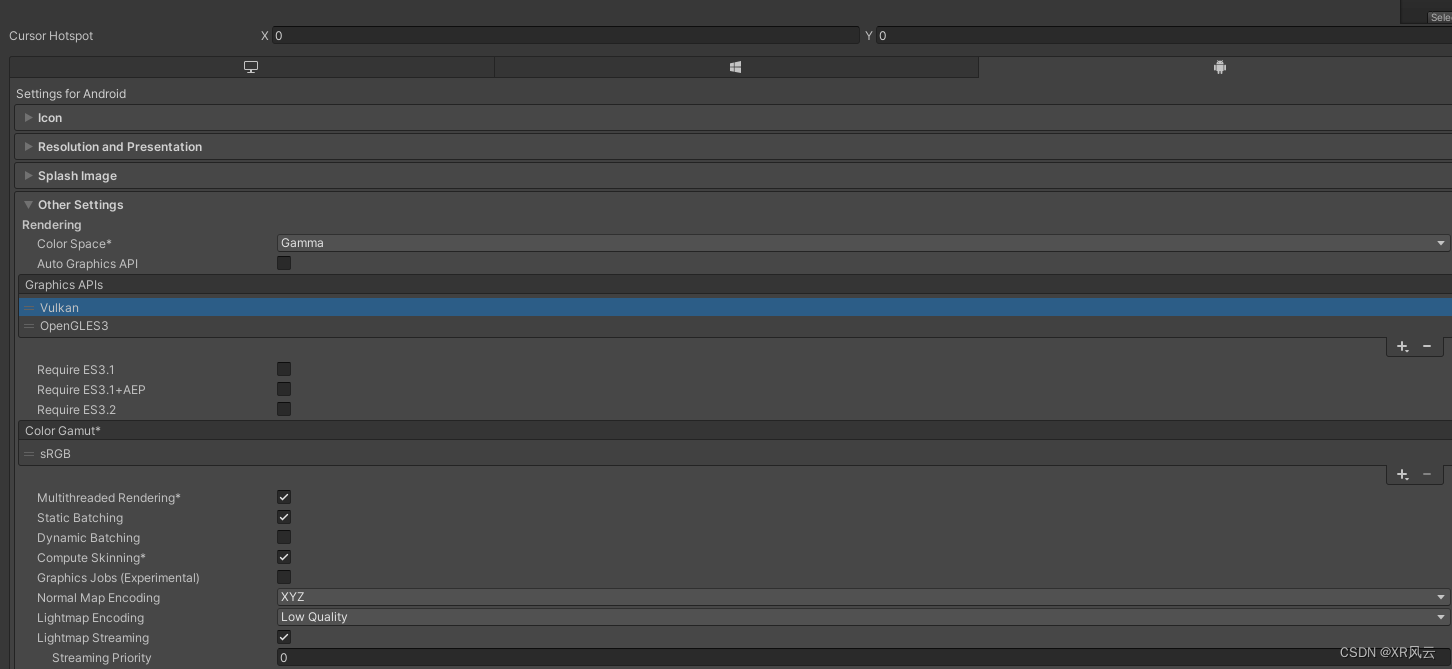在上一文我们对Unity实时更新纹理数据做了一些研究,但是最后有一步骤,texture.Apply()依然需要在渲染线程中执行,这个函数其实也是非常耗时的,依然会影响到应用的FPS。
这篇文章用了另外一条思路,就是开一个线程,主要处理纹理更新的线程,主要是参考了Unity 的NativeRenderingPlugin插件来写的,搞一个Unity单独更新纹理的插件。
1、EGL
在Android平台上,EGL是OpenGL ES与本地窗口系统(本机窗口系统)之间的通信接口,其主要功能:
与设备的原生窗口系统通信;
查询绘图曲面的可用类型和配置;
创建图形曲面;
保持OpenGL ES和其他图形渲染API之间的同步渲染;
管理渲染资源,如纹理贴图。
OpenGL ES它在EGL实现的帮助下,EGL屏蔽了不同平台之间的差异(苹果提供您自己的EGL API Of iOS实现,声称是EAGL)。
本地窗口相关API提供对本地窗口系统接口的访问,EGL您可以创建渲染曲面EGLSurface,同时,它提供图形渲染上下文EGLContext,用于状态管理,下一个OpenGL ES您可以在此渲染曲面上绘制。
2、共享上下文时,哪些资源可以跨线程共享?
可共享的资源:
texture ;
shader;
program Shader program ;
buffer Class object , Such as VBO、 EBO、 RBO etc. .
无法共享的资源:
FBO Framebuffer object ( Do not belong to buffer class );
VAO Vertex array object ( Do not belong to buffer class ).
这里的解释是,在无法共享的资源中,FBO和VAO它是一个资源管理对象,FBO负责管理多个缓冲区,它不占用资源,VAO负责管理VBO或EBO,它不占用资源。
3、多线程实时更新纹理
在我们开发实时更新纹理的过程中,我们就使用到了EGL这个库,以及共享上下文的特性。
第一步,我们需要写一个Unity Native Plugins来做渲染事情,可以参考GitHub - Unity-Technologies/NativeRenderingPlugin: C++ Rendering Plugin example for Unity![]() https://github.com/Unity-Technologies/NativeRenderingPlugin
https://github.com/Unity-Technologies/NativeRenderingPlugin
第二步,我们在Plugins中,加入我们多线程的一个处理方法。
总体的Plugin代码如下:
// Example low level rendering Unity plugin
#include "PlatformBase.h"
#include "RenderAPI.h"
#include "TextureRender.h"
#include "SafeQueue.h"
#include <EGL/egl.h>
#include <GLES3/gl3.h>
#include <assert.h>
#include <math.h>
#include <stdio.h>
#include <vector>
#include <unistd.h>
#include <jni.h>
static float g_Time;
static void *g_TextureHandle = NULL;
static int g_TextureWidth = 0;
static int g_TextureHeight = 0;
SafeQueue<TextureDataInfo> texDatas;
/* Context related variables. */
EGLContext mainContext = NULL;
EGLContext mainDisplay = NULL;
EGLSurface pBufferSurface = NULL;
EGLContext pBufferContext = NULL;
/* Secondary thread related variables. */
pthread_t secondThread = -1;
bool exitThread = false;
/* Sync objects. */
GLsync mainThreadSyncObj = NULL;
GLuint64 timeout = GL_TIMEOUT_IGNORED;
// --------------------------------------------------------------------------
// UnitySetInterfaces
static void UNITY_INTERFACE_API OnGraphicsDeviceEvent(UnityGfxDeviceEventType eventType);
static IUnityInterfaces *s_UnityInterfaces = NULL;
static IUnityGraphics *s_Graphics = NULL;
extern "C" void UNITY_INTERFACE_EXPORT UNITY_INTERFACE_API
UnityPluginLoad(IUnityInterfaces *unityInterfaces) {
s_UnityInterfaces = unityInterfaces;
s_Graphics = s_UnityInterfaces->Get<IUnityGraphics>();
s_Graphics->RegisterDeviceEventCallback(OnGraphicsDeviceEvent);
#if SUPPORT_VULKAN
if (s_Graphics->GetRenderer() == kUnityGfxRendererNull) {
extern void RenderAPI_Vulkan_OnPluginLoad(IUnityInterfaces *);
RenderAPI_Vulkan_OnPluginLoad(unityInterfaces);
}
#endif // SUPPORT_VULKAN
// Run OnGraphicsDeviceEvent(initialize) manually on plugin load
OnGraphicsDeviceEvent(kUnityGfxDeviceEventInitialize);
}
extern "C" void UNITY_INTERFACE_EXPORT UNITY_INTERFACE_API UnityPluginUnload() {
s_Graphics->UnregisterDeviceEventCallback(OnGraphicsDeviceEvent);
}
#if UNITY_WEBGL
typedef void (UNITY_INTERFACE_API * PluginLoadFunc)(IUnityInterfaces* unityInterfaces);
typedef void (UNITY_INTERFACE_API * PluginUnloadFunc)();
extern "C" void UnityRegisterRenderingPlugin(PluginLoadFunc loadPlugin, PluginUnloadFunc unloadPlugin);
extern "C" void UNITY_INTERFACE_EXPORT UNITY_INTERFACE_API RegisterPlugin()
{
UnityRegisterRenderingPlugin(UnityPluginLoad, UnityPluginUnload);
}
#endif
// --------------------------------------------------------------------------
// GraphicsDeviceEvent
static RenderAPI *s_CurrentAPI = NULL;
static UnityGfxRenderer s_DeviceType = kUnityGfxRendererNull;
static void UNITY_INTERFACE_API OnGraphicsDeviceEvent(UnityGfxDeviceEventType eventType) {
// Create graphics API implementation upon initialization
if (eventType == kUnityGfxDeviceEventInitialize) {
assert(s_CurrentAPI == NULL);
s_DeviceType = s_Graphics->GetRenderer();
s_CurrentAPI = CreateRenderAPI(s_DeviceType);
}
// Let the implementation process the device related events
if (s_CurrentAPI) {
s_CurrentAPI->ProcessDeviceEvent(eventType, s_UnityInterfaces);
}
// Cleanup graphics API implementation upon shutdown
if (eventType == kUnityGfxDeviceEventShutdown) {
delete s_CurrentAPI;
s_CurrentAPI = NULL;
s_DeviceType = kUnityGfxRendererNull;
}
}
static void ModifyTexturePixels(void *data) {
void *textureHandle = g_TextureHandle;
int width = g_TextureWidth;
int height = g_TextureHeight;
if (!textureHandle)
return;
if (!data)
return;
s_CurrentAPI->EndModifyTexture(textureHandle, width, height, 0, data);
}
/* Modify the texture. */
void* animateTexture() {
int textureRowPitch;
void* textureDataPtr = s_CurrentAPI->BeginModifyTexture(g_TextureHandle, g_TextureWidth, g_TextureHeight, &textureRowPitch);
if (!textureDataPtr)
return NULL;
const float t = g_Time * 4.0f;
unsigned char* dst = (unsigned char*)textureDataPtr;
for (int y = 0; y < g_TextureHeight; ++y)
{
unsigned char* ptr = dst;
for (int x = 0; x < g_TextureWidth; ++x)
{
// Simple "plasma effect": several combined sine waves
int vv = int(
(127.0f + (127.0f * sinf(x / 7.0f + t))) +
(127.0f + (127.0f * sinf(y / 5.0f - t))) +
(127.0f + (127.0f * sinf((x + y) / 6.0f - t))) +
(127.0f + (127.0f * sinf(sqrtf(float(x*x + y*y)) / 4.0f - t)))
) / 4;
// Write the texture pixel
ptr[0] = vv;
ptr[1] = vv;
ptr[2] = vv;
ptr[3] = vv;
// To next pixel (our pixels are 4 bpp)
ptr += 4;
}
// To next image row
dst += textureRowPitch;
}
return textureDataPtr;
}
/* [workingFunction 1] */
/* Secondary thread's working function. */
static void *workingFunction(void *arg) {
EGLConfig config = findConfig(mainDisplay, true, true);
pBufferSurface = eglCreatePbufferSurface(mainDisplay, config, pBufferAttributes);
if (pBufferSurface == EGL_NO_SURFACE) {
EGLint error = eglGetError();
LOGE("eglGetError(): %i (0x%.4x)\n", (int) error, (int) error);
LOGE("Failed to create EGL pixel buffer surface at %s:%i\n", __FILE__, __LINE__);
exit(1);
}
LOGI("PBuffer surface created successfully.\n");
/* Unconditionally bind to OpenGL ES API. */
eglBindAPI(EGL_OPENGL_ES_API);
/* [Creating rendering context] */
/* Sharing OpenGL ES objects with main thread's rendering context. */
pBufferContext = eglCreateContext(mainDisplay, config, mainContext, contextAttributes);
/* [Creating rendering context] */
if (pBufferContext == EGL_NO_CONTEXT) {
EGLint error = eglGetError();
LOGE("eglGetError(): %i (0x%.4x)\n", (int) error, (int) error);
LOGE("Failed to create EGL pBufferContext at %s:%i\n", __FILE__, __LINE__);
exit(1);
}
LOGI("PBuffer context created successfully sharing GLES objects with the main context.\n");
eglMakeCurrent(mainDisplay, pBufferSurface, pBufferSurface, pBufferContext);
LOGI("PBuffer context made current successfully.\n");
/*
* Flags to pass to glFenceSync must be zero as there are no flag defined yet.
* The condition must be set to GL_SYNC_GPU_COMMANDS_COMPLETE.
*/
GLbitfield flags = 0;
GLenum condition = GL_SYNC_GPU_COMMANDS_COMPLETE;
while (!exitThread) {
if (mainThreadSyncObj != NULL) {
glWaitSync(mainThreadSyncObj, flags, timeout);
} else {
LOGI("mainThreadSyncObj is null");
continue;
}
TextureDataInfo tempData;
if (texDatas.Consume(tempData)) {
ModifyTexturePixels(tempData.data);
free(tempData.data);
}else {
void * data = animateTexture();
if(data == NULL)
continue;
ModifyTexturePixels(data);
free(data);
}
}
LOGI("Exiting secondary thread.\n");
return NULL;
}
void createTextureThread(void) {
pthread_create(&secondThread, NULL, &workingFunction, NULL);
}
void startTextureRender() {
if (secondThread != -1) {
LOGD("thread is started!");
return;
}
mainContext = eglGetCurrentContext();
if (mainContext == EGL_NO_CONTEXT) {
LOGE("initCL: eglGetCurrentContext() returned 'EGL_NO_CONTEXT', error = %x", eglGetError());
return;
}
mainDisplay = eglGetCurrentDisplay();
if(mainDisplay == EGL_NO_DISPLAY) {
LOGE("initCL: eglGetCurrentDisplay() returned 'EGL_NO_DISPLAY', error = %x", eglGetError());
return;
}
createTextureThread();
exitThread = false;
}
void stopTextureRender() {
exitThread = true;
TextureDataInfo tempData;
while (texDatas.Consume(tempData)) {
free(tempData.data);
}
secondThread = -1;
}
void addTextureData(TextureDataInfo dataInfo) {
if (texDatas.Size() > 20) {
LOGD("texDatas is large");
TextureDataInfo tempData;
if (texDatas.Consume(tempData)) {
free(tempData.data);
}
}
texDatas.Produce(std::move(dataInfo));
}
void renderFrame() {
GLbitfield flags = 0;
GLenum condition = GL_SYNC_GPU_COMMANDS_COMPLETE;
mainThreadSyncObj = glFenceSync(condition, flags);
}
static void UNITY_INTERFACE_API OnRenderEvent(int eventID) {
// Unknown / unsupported graphics device type? Do nothing
if (s_CurrentAPI == NULL)
return;
renderFrame();
}
extern "C" void UNITY_INTERFACE_EXPORT UNITY_INTERFACE_API SetTimeFromUnity (float t) { g_Time = t; }
extern "C" void UNITY_INTERFACE_EXPORT UNITY_INTERFACE_API
StartTextureRender(void *textureHandle, int w, int h) {
// A script calls this at initialization time; just remember the texture pointer here.
// Will update texture pixels each frame from the plugin rendering event (texture update
// needs to happen on the rendering thread).
g_TextureHandle = textureHandle;
g_TextureWidth = w;
g_TextureHeight = h;
LOGI("texture width: %d, height: %d", w, h);
startTextureRender();
}
extern "C" void UNITY_INTERFACE_EXPORT UNITY_INTERFACE_API
StopTextureRender() {
stopTextureRender();
}
// --------------------------------------------------------------------------
// GetRenderEventFunc, an example function we export which is used to get a rendering event callback function.
extern "C" UnityRenderingEvent UNITY_INTERFACE_EXPORT UNITY_INTERFACE_API GetRenderEventFunc() {
return OnRenderEvent;
}
extern "C" void UNITY_INTERFACE_EXPORT UNITY_INTERFACE_API
UpdateTextureDataPtr(void *data, int len) {
void *tempData = new unsigned char[len];
if (tempData == NULL)
return;
memcpy(tempData, data, len);
TextureDataInfo dataInfo;
dataInfo.data = tempData;
dataInfo.len = len;
addTextureData(dataInfo);
}
Unity中使用方法:
using System;
using System.Runtime.InteropServices;
using UnityEngine;
public class MutilTextureRenderer : MonoBehaviour
{
[SerializeField]
private MeshRenderer imageRenderer;
[SerializeField, Tooltip("Frequency of sharing screens")]
private int frequency = 10;
private const string mainTexPropertyName = "_MainTex";
private Texture2D imageTexture;
private int imageWidth = 1920;
private int imageHeight = 1080;
public void OnDestroy()
{
NDKAPI.StopTextureRender();
if (imageTexture != null)
DestroyImmediate(imageTexture);
}
// Start is called before the first frame update
void Start()
{
if (imageTexture == null)
{
imageTexture = new Texture2D(imageWidth, imageHeight, TextureFormat.RGBA32, false, true);
imageTexture.wrapMode = TextureWrapMode.Clamp;
imageRenderer.material.SetTexture(mainTexPropertyName, imageTexture);
// Pass texture pointer to the plugin
NDKAPI.StartTextureRender(imageTexture.GetNativeTexturePtr(), imageTexture.width, imageTexture.height);
}
}
// Update is called once per frame
private void Update()
{
NDKAPI.SetTimeFromUnity(Time.timeSinceLevelLoad);
GL.IssuePluginEvent(NDKAPI.GetRenderEventFunc(), 1);
}
public struct NDKAPI
{
#if (UNITY_IOS || UNITY_TVOS || UNITY_WEBGL) && !UNITY_EDITOR
[DllImport ("__Internal")]
#else
[DllImport("RenderingPlugin")]
#endif
public static extern IntPtr GetRenderEventFunc();
#if (UNITY_IOS || UNITY_TVOS || UNITY_WEBGL) && !UNITY_EDITOR
[DllImport ("__Internal")]
#else
[DllImport("RenderingPlugin")]
#endif
public static extern void StartTextureRender(System.IntPtr texture, int w, int h);
#if (UNITY_IOS || UNITY_TVOS || UNITY_WEBGL) && !UNITY_EDITOR
[DllImport ("__Internal")]
#else
[DllImport("RenderingPlugin")]
#endif
public static extern void StopTextureRender();
#if (UNITY_IOS || UNITY_TVOS || UNITY_WEBGL) && !UNITY_EDITOR
[DllImport ("__Internal")]
#else
[DllImport("RenderingPlugin")]
#endif
public static extern void UpdateTextureDataPtr(System.IntPtr data, int len);
#if (UNITY_IOS || UNITY_TVOS || UNITY_WEBGL) && !UNITY_EDITOR
[DllImport ("__Internal")]
#else
[DllImport("RenderingPlugin")]
#endif
public static extern void SetTimeFromUnity(float t);
}
}
总体效果

常见问题
出现如下错误:
2022/05/06 14:23:17.861 22872 22917 Error libNative initCL: eglGetCurrentContext() returned 'EGL_NO_CONTEXT', error = 3000
需要在Unity中把Graphics APIS中的Vulkan去掉,以及勾选掉Multithreaded Rendering勾选掉。

我的demo代码下载地址:Unity多线程实时更新纹理数据(Android平台)-Android文档类资源-CSDN下载我们需要实时更新纹理数据,如果在主线程中更新,会影响帧率。当前我们在?Unity中搞了一个Naitv更多下载资源、学习资料请访问CSDN下载频道. https://download.csdn.net/download/grace_yi/85301879
https://download.csdn.net/download/grace_yi/85301879
参考文献
https://github.com/ARM-software/opengl-es-sdk-for-android/blob/4ca9fdb10bcd721bb9af19ccd9bdd95bdf34a07b/samples/advanced_samples/ThreadSync/jni/ThreadSync.cpp![]() https://github.com/ARM-software/opengl-es-sdk-for-android/blob/4ca9fdb10bcd721bb9af19ccd9bdd95bdf34a07b/samples/advanced_samples/ThreadSync/jni/ThreadSync.cppMultithreading rendering with OpenGL es shared context - 文章整合
https://github.com/ARM-software/opengl-es-sdk-for-android/blob/4ca9fdb10bcd721bb9af19ccd9bdd95bdf34a07b/samples/advanced_samples/ThreadSync/jni/ThreadSync.cppMultithreading rendering with OpenGL es shared context - 文章整合![]() https://chowdera.com/2021/06/20210619181834707p.html
https://chowdera.com/2021/06/20210619181834707p.html
